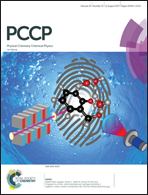Reply to the ‘Comment on “Proton transport in barium stannate: classical, semi-classical and quantum regime”’
Abstract
We respond to the erroneous criticisms about our modeling of proton transport in barium stannate [G. Geneste et al., Phys. Chem. Chem. Phys., 2015, 17, 19104]. In this previous work, we described, on the basis of density-functional calculations, proton transport in the classical and semi-classical regimes, and provided arguments in favor of an adiabatic picture for proton transfer at low temperature. We re-explain here our article (with more detail and precision), the content of which has been distorted in the Comment, and reiterate our arguments in this reply. We refute all criticisms. They are completely wrong in the context of our article. Even though a few of them are based on considerations probably true in some metals, they make no sense here since they do not correspond to the content of our work. It has not been understood in the Comment that two competitive configurations, associated with radically different transfer mechanisms, have been studied in our work. It has also not been understood in the Comment that the adiabatic regime described for transfer occurs in the protonic ground state, in a very-low barrier configuration with the protonic ground state energy larger than the barrier. Serious confusion has been made in the Comment with the case of H in metals like Nb or Ta, leading to the introduction of the notion of (protonic) “excited-state proton transfer”, relevant for H in some metals, but (i) that does not correspond to the (ground state) adiabatic transfers here described, and (ii) that does not correspond to what is commonly described as the “adiabatic limit for proton transfer” in the scientific literature. We emphasize, accordingly, the large differences between proton transfer in the present oxide and hydrogen jumps in metals like Nb or Ta, and the similarities between proton transfer in the present oxide and in acid–base solutions. We finally describe a scenario for proton transfer in the present oxide regardless of the temperature regime.



 Please wait while we load your content...
Please wait while we load your content...